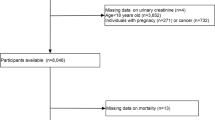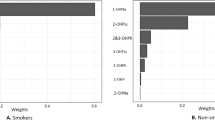Abstract
The field of environmental health has begun to examine the effects of higher-order chemical combinations. The current literature lacks studies exploring associations between multiple organic chemical mixtures and cardiometabolic diseases (CVDs). This study aimed to evaluate associations between urinary phenols, parabens metabolites, and total and individual CVDs among a nationally representative sample of adults in the US. This cross-sectional study analyzed 7 urinary chemicals detected among the general population from the 2005–2016 National Health and Nutrition Examination Survey (NHANES, n=10,428). Multivariate logistic regression and weighted quantile sum (WQS) regression were applied to examine relationships between phenols and parabens metabolites, alone and in combination, and total and individual CVDs prevalence. Compared with the lowest quartile, URBPA (OR: 1.52; 95% CI: 1.20–1.91; P=0.001) levels in the highest quartile were independently associated with increased total CVD. The WQS index of phenols and parabens mixtures were independently correlated with total CVD (adjusted odds ratios [OR]: 1.16; 95% confidence interval [CI]:1.06–1.28; P=0.002), angina (adjusted OR: 1.30; 95% CI: 1.07–1.59; P=0.009), and heart attack (adjusted OR: 1.30; 95% CI: 1.12–1.51, P<0.001). Urinary bisphenol A (URBPA, weight=0.636) was the most heavily weighted component in the total CVD model. Restricted cubic spline regression demonstrated positive correlations and nonlinear associations between URBPA and both total CVD (P for nonlinearity=0.032) and individual CVD (heart attack; P for nonlinearity=0.031). Our findings suggested that high combined levels of phenols, and parabens are associated with an increased CVD risk, with URBPA contributing the highest risk.




Similar content being viewed by others
Data availability
The datasets used and analyzed during the current study are available from https://www.cdc.gov/nchs/nhanes/about_nhanes.htm.
References
Ahn KC, Zhao B, Chen J, Cherednichenko G, Sanmarti E, Denison MS, Lasley B, Pessah IN, Kültz D, Chang DPY, Gee SJ, Hammock BD (2008) In vitro biologic activities of the antimicrobials triclocarban, its analogs, and triclosan in bioassay screens: receptor-based bioassay screens. Environ Health Perspect 116:1203–1210
Andrea B, Yu-Han C, Florence M. B, Mínguez-Alarcón L, Ford JB, John P et al (2019) Urinary concentrations of parabens mixture and pregnancy glucose levels among women from a fertility clinic. Environ Res 168:389–396
Andreia G, Carole Oudot, Alba M, Alexandre F, Carregosa D, Stewart D et al (2019) Berry-enriched diet in salt-sensitive hypertensive rats: metabolic fate of (poly)phenols and the role of Gut microbiota. Nutrients 11(11):2634
Benjamin EJ, Blaha MJ, Chiuve SE, Cushman M, Das SR, Deo R, de Ferranti SD, Floyd J, Fornage M, Gillespie C, Isasi CR, Jiménez MC, Jordan LC, Judd SE, Lackland D, Lichtman JH, Lisabeth L, Liu S, Longenecker CT, Mackey RH, Matsushita K, Mozaffarian D, Mussolino ME, Nasir K, Neumar RW, Palaniappan L, Pandey DK, Thiagarajan RR, Reeves MJ, Ritchey M, Rodriguez CJ, Roth GA, Rosamond WD, Sasson C, Towfighi A, Tsao CW, Turner MB, Virani SS, Voeks JH, Willey JZ, Wilkins JT, Wu JH, Alger HM, Wong SS, Muntner P, American Heart Association Statistics Committee and Stroke Statistics Subcommittee (2017) Heart disease and stroke statistics-2017 update: a report from the American Heart Association. Circulation 135:e146–e603
Bhatnagar A (2006) Environmental cardiology: studying mechanistic links between pollution and heart disease. Circ Res 99(7):692–705
Calafat AM, Ye X, Wong LY, Bishop AM, Needham LL (2010) Urinary concentrations of four parabens in the U.S. population: NHANES 2005–2006. Environ Health Perspect 118:679–685
Calafat AM, Valentin-Blasini L, Ye X (2015) Trends in exposure to chemicals in personal care and consumer products. Curr Environ Health Rep 2(4):348–355
Carrico C, Gennings C, Wheeler DC, Factor-Litvak P (2015) Characterization of weighted quantile sum regression for highly correlated data in a risk analysis setting. J Agric Biol Environ Stat 20:100–120
Cherednichenko G, Zhang R, Bannister RA, Timofeyev V, Li N, Fritsch EB, Feng W, Barrientos GC, Schebb NH, Hammock BD, Beam KG, Chiamvimonvat N, Pessah IN (2012) Triclosan impairs excitation-contraction coupling and Ca2+ dynamics in striated muscle. Proc Natl Acad Sci U S A 109:14158–14163
Chris G, Paul C, Ghalib B, Robert W, Arora M, Austina C (2020) Lagged WQS regression for mixtures with many components. Environ Res 186:109529
Cicero AF, Fogacci F, Colletti A (2017) Food and plant bioactives for reducing cardiometabolic disease risk: an evidence based approach. Food Funct 8(6):2076–2088
Danting W, Yuhuan Z, Jieyi L, Dahlgren RA, Xuedong W, Huang H et al (2020) Risk assessment of cardiotoxicity to zebrafish (Danio rerio) by environmental exposure to triclosan and its derivatives. Environ Pollut 265(Pt A):114995
Dodson RE, Nishioka M, Standley LJ, Perovich LJ, Brody JG, Rudel RA (2012) Endocrine disruptors and asthma-associated chemicals in consumer products. Environ Health Perspect 120:935–943
Fangjian G, W. TG (2016) Trends in cardiovascular health metrics in obese adults: national health and nutrition examination survey (NHANES), 1988–2014. J Am Heart Assoc 5(7):e003619
Ferguson KK, Cantonwine DE, McElrath TF, Mukherjee B, Meeker JD (2016) Repeated measures analysis of associations between urinary bisphenol-A concentrations and biomarkers of inflammation and oxidative stress in pregnancy. Reprod Toxicol 66:93–98
GBD 2016 Causes of Death Collaborators (2017) Global, regional, and national age-sex specific mortality for 264 causes of death, 1980-2016: a systematic analysis for the Global Burden of Disease Study 2016. Lancet 390:1151–1210
GBD 2016 DALYs and HALE Collaborators (2017) Global, regional, and national disability-adjusted life-years (DALYs) for 333 diseases and injuries and healthy life expectancy (HALE) for 195 countries and territories, 1990-2016: a systematic analysis for the Global Burden of Disease Study 2016. Lancet 390:1260–1344
Goodson WH III, Lowe L, Carpenter DO, Gilbertson M, Manaf Ali A, de Cerain Lopez, Salsamendi A et al (2015) Assessing the carcinogenic potential of low-dose exposures to chemical mixtures in the environment: the challenge ahead. Carcinogenesis 36(Suppl 1):S254–S296
Habauzit V, Morand C (2012) Evidence for a protective effect of polyphenols containing foods on cardiovascular health: an update for clinicians. Ther Adv Chronic Dis 3:87–106
Han C, Hong YC, Bisphenol A (2016) Hypertension, and cardiovascular diseases: epidemiological, laboratory, and clinical trial evidence. Curr Hypertens Rep 18(2):11
Harold I. Z (2013) Lipophilic chemical exposure as a cause of cardiovascular disease. Interdiscip Toxicol 6(2):55–62
Hartung T (2009) Toxicology for the twenty-first century. Nature 460(7252):208–212
Ilaria C, Francesca F, Giuseppe P, Claudia M, Beguinot F, Formisano P et al (2020) Potential mechanisms of bisphenol a (BPA) contributing to human disease. Int J Mol Sci 21(16):5761
Julia B. W, Sarah S. C, Catherine C. C (2020) Urinary phenols and parabens and diabetes among US adults, NHANES 2005–2014. Nutr Metab Cardiovasc Dis 30(5):768–776
Juyoung S, Lisa M. W, Luc RH, Maxwell T. D, Andy N, Ryan N et al (2016) Triclosan is a mitochondrial uncoupler in live zebrafish. J Appl Toxicol 36(12):1662–1667
Katelyn Ann B, Jessica Elizabeth M, Alex Lingyun Y, Frisancho JA, Scott AJ, Henry David G et al (2019) BPA alters estrogen receptor expression in the heart after viral infection activating cardiac mast cells and T cells leading to perimyocarditis and fibrosis. Front Endocrinol (Lausanne) 10:598
Kerimi A, Williamson G (2016) At the interface of antioxidant signalling and cellular function: key polyphenol effects. Mol Nutr Food Res 60(8):1770–1788
Krga I, Milenkovic D, Morand C, Monfoulet LE (2016) An update on the role of nutrigenomic modulations in mediating the cardiovascular protective effect of fruit polyphenols. Food Funct 7(9):3656–3676
Lesliam Q-A, Jessie P. B, Meleah B (2018) Parabens and measures of adiposity among adults and children from the U.S. general population: NHANES 2007-2014. Int J Hyg Environ Health 221(4):652–660
Liu B, Lehmler HJ, Sun Y, Xu G, Liu Y, Zong G et al (2017) Bisphenol a substitutes and obesity in US adults: analysis of a population-based, cross-sectional study. Lancet Planet Health 1(3):e114–e122
Nietch CT, Quinlan EL, Lazorchak JM, Impellitteri CA, Raikow D, Walters D (2013) Effects of a chronic lower range of triclosan exposure on a stream mesocosm community. Environ Toxicol Chem 32:2874–2887
Quiros-Alcala L, Buckley JP, Boyle M (2018) Parabens and measures of adiposity among adults and children from the U.S. general population: NHANES 2007-2014. Int J Hyg Environ Health 221:652–660
Rachel D. Z, Elizabeth K. C, Michal Freedman D, Martha S. L (2015) Self-reported sunscreen use and urinary benzophenone-3 concentrations in the United States: NHANES 2003-2006 and 2009-2012. Environ Res 142:563–567
Reventun P, Sanchez-Esteban S, Cook A, Cuadrado I, Roza C, Moreno-Gomez-Toledano R, Muñoz C, Zaragoza C, Bosch RJ, Saura M (2020) Bisphenol A induces coronary endothelial cell necroptosis by activating RIP3/CamKII dependent pathway. Sci Rep 10:4190
Robert M. S, Rebecca A. S (2019) Environmental neglect: endocrine disruptors as underappreciated but potentially modifiable diabetes risk factors. Diabetologia 62(10):1811–1822
Ruiz D, Becerra M, Jagai JS, Ard K, Sargis RM (2018) Disparities in environmental exposures to endocrine-disrupting chemicals and diabetes risk in vulnerable populations. Diabetes Care 41(1):193–205
Stephanie K. B, Robert B, Werner B, Silvia Dalla C, Dorne J-LCM, Drakvik PE et al (2018) Current EU research activities on combined exposure to multiple chemicals. Environ Int 120:544–562
Stephanie C, Joelle H, Youakim S, Patrick B, Louka N, Maroun RG et al (2019) Long-term intake of phenolic compounds attenuates age-related cardiac remodeling. Aging Cell 18(2):e12894
Symielle A. G, Linda S. B, Chandra L. J (2020) Synthetic chemicals and cardiometabolic health across the life course among vulnerable populations: a review of the literature from 2018 to 2019. Curr Environ Health Rep 7(1):30–47
Traci N. B, Amelia K. W, Jennifer W, McClean MD, Russ H, Williams PL et al (2020) Correlates of exposure to phenols, parabens, and triclocarban in the study of environment, lifestyle and fibroids. J Expo Sci Environ Epidemiol 30(1):117–136
van der Thomas P. M, van Martjn F, van André P. B, Harold S, Kema IP, Wolffenbuttel BHR et al (2020) Exposure to endocrine disrupting chemicals in the Dutch general population is associated with adiposity-related traits. Sci Rep 10:9311
Wilhelm M, Ewers U, Schulz C (2003) Revised and new reference values for some persistent organic pollutants (POPs) in blood for human biomonitoring in environmental medicine. Int J Hyg Environ Health 206(3):223–229
Yueh MF, Taniguchi K, Chen S, Evans RM, Hammock BD, Karin M, Tukey RH (2014) The commonly used antimicrobial additive triclosan is a liver tumor promoter. Proc Natl Acad Sci 111:17200–17205
Acknowledgements
The authors would like to thank the CDC for conducting the NHANES survey and NCHS staff for providing us with consultation on the application of survey weights. This research did not receive any specific grants from any funding agencies in the public, commercial, or not-for-profit sectors.
Author information
Authors and Affiliations
Contributions
Ting Yin and Xu Zhu designed and conceived the study proposal, conducted statistical analyses, and drafted the manuscript. Ting Yin, Iokfai Cheang, and Shengen Liao critically revised the manuscript. Yufei Zhou, **nyi Lu, and Yanli Zhou performed the bibliographic research and analyzed the data. Haifeng Zhang and Wenming Yao conceived and led the design of the study and model. **nli Li revised the manuscript. All authors have read and approved the final article.
Corresponding authors
Ethics declarations
Ethics approval and consent to participate
The consent form was signed by all participants in the survey, and participants consented to store specimens of their blood for future research. The CDC/NCHS Ethics Review Board approved the NHANES study and gave approval for public dissemination.
Consent for publication
Not applicable. There is no individual-level data in our publication.
Competing interests
The authors declare no competing interests.
Additional information
Responsible Editor: Lotfi Aleya
Publisher’s note
Springer Nature remains neutral with regard to jurisdictional claims in published maps and institutional affiliations.
Rights and permissions
About this article
Cite this article
Yin, T., Zhu, X., Cheang, I. et al. Urinary phenols and parabens metabolites associated with cardiovascular disease among adults in the United States. Environ Sci Pollut Res 30, 25093–25102 (2023). https://doi.org/10.1007/s11356-021-15589-5
Received:
Accepted:
Published:
Issue Date:
DOI: https://doi.org/10.1007/s11356-021-15589-5






